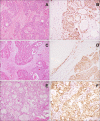Immunohistochemical Assessment of BAP1 Protein in Mucoepidermoid Carcinomas
- PMID: 30906710
- PMCID: PMC6401040
- DOI: 10.1007/s12070-018-1549-3
Immunohistochemical Assessment of BAP1 Protein in Mucoepidermoid Carcinomas
Abstract
Mucoepidermoid carcinomas are common malignant salivary gland tumors. Despite recent advances in diagnosis and treatment, there has not been much improvement in outcome of these patients, necessitating identification of novel targeted therapeutic agents. Genomic profiling of mucoepidermoid carcinomas has recently revealed aberrations in BAP1 gene. Therefore, we conducted this study to identify BAP1 loss by immunohistochemistry in these tumors. Mucoepidermoid carcinoma cases were retrieved; hematoxylin-and-eosin stained sections were reviewed. Immunohistochemistry for BAP1 was performed. Forty cases were assessed, including 25 salivary gland and 15 pulmonary mucoepidermoid carcinomas. There were 19 cases in the parotid (76%), two in submandibular gland (8%), and remaining 16% from minor salivary gland locations. Ten (40%) were low grade, nine (36%) were intermediate grade, and six (24%) were high grade mucoepidermoid carcinomas. Thirteen (86.7%) pulmonary mucoepidermoid carcinomas were tracheobronchial, while two (13.3%) were intraparenchymal; all were low grade mucoepidermoid carcinomas. On immunohistochemistry, BAP1 nuclear staining was retained in all cases (100%), irrespective of tumor location or grade. Therapeutic connotations necessitate the identification of readily applicable techniques to detect BAP1 loss in mucoepidermoid carcinomas. Using immunohistochemistry, loss of BAP1 staining was not seen in any of our cases, suggesting insensitivity of BAP1 IHC to detect aberrations at genomic level in these tumors. Analysis of BAP1 alterations by targeted sequencing may therefore be performed prior to excluding the possibility of response to BAP1-targeted therapeutics based on immunohistochemistry alone.
Keywords: BAP1; Bronchopulmonary tumor; Mucoepidermoid carcinoma; Parotid; Salivary gland tumor.
Conflict of interest statement
Compliance with Ethical StandardsThe authors declared that they have no conflict of interest.
Figures

Similar articles
-
Comprehensive genomic profiling of salivary mucoepidermoid carcinomas reveals frequent BAP1, PIK3CA, and other actionable genomic alterations.Ann Oncol. 2017 Apr 1;28(4):748-753. doi: 10.1093/annonc/mdw689. Ann Oncol. 2017. PMID: 28327999
-
Oncocytic mucoepidermoid carcinoma of the salivary glands.Am J Surg Pathol. 1999 May;23(5):523-9. doi: 10.1097/00000478-199905000-00005. Am J Surg Pathol. 1999. PMID: 10328083 Review.
-
PCNA, Ki-67 and p53 expressions in submandibular salivary gland tumours.Int J Oral Maxillofac Surg. 2004 Sep;33(6):593-7. doi: 10.1016/j.ijom.2004.01.010. Int J Oral Maxillofac Surg. 2004. PMID: 15308260
-
Intra-Cystic (In Situ) Mucoepidermoid Carcinoma: A Clinico-Pathological Study of 14 Cases.J Clin Med. 2020 Apr 18;9(4):1157. doi: 10.3390/jcm9041157. J Clin Med. 2020. PMID: 32325647 Free PMC article.
-
Salivary gland-like tumors of the breast express basal-type immunohistochemical markers.Appl Immunohistochem Mol Morphol. 2013 Jul;21(4):283-6. doi: 10.1097/PAI.0b013e31826a277e. Appl Immunohistochem Mol Morphol. 2013. PMID: 22935826 Review.
Cited by
-
Loss of BAP1 Protein Expression by Immunohistochemistry in the Salivary Duct Carcinoma Component of an Intracapsular Carcinoma ex Pleomorphic Adenoma of the Parotid Gland.Head Neck Pathol. 2023 Sep;17(3):851-854. doi: 10.1007/s12105-023-01579-1. Epub 2023 Aug 18. Head Neck Pathol. 2023. PMID: 37594632 Free PMC article.
References
-
- Wahlberg P, Anderson H, Biorklund A, et al. Carcinoma of the parotid and submandibular glands—a study of survival in 2465 patients. Oral Oncol. 2002;38:706–713. - PubMed
-
- Jones AV, Craig GT, Speight PM, et al. The range and demo-graphics of salivary gland tumours diagnosed in a UK population. Oral Oncol. 2008;44:407–417. - PubMed
-
- Wang K, McDermott JD, Schrock AB, et al. Comprehensive genomic profiling of salivary mucoepidermoid carcinomas reveals frequent BAP1, PIK3CA, and other actionable genomic alterations. Ann Oncol. 2017;28:748–753. - PubMed
-
- Brandwein MS, Ivanov K, Wallace DI, et al. Mucoepidermoid carcinoma: a clinicopathologic study of 80 patients with special reference to histological grading. Am J Surg Pathol. 2001;25:835–845. - PubMed
LinkOut - more resources
Full Text Sources
